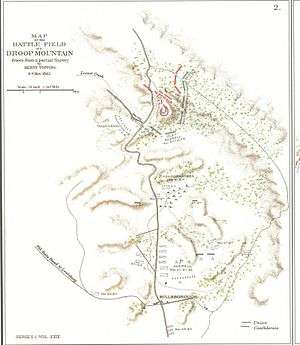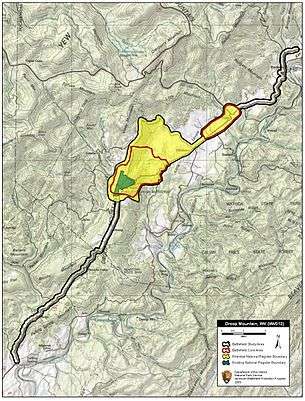Battle of Droop Mountain
The Battle of Droop Mountain was a battle in Pocahontas County, West Virginia, that occurred November 6, 1863, during the American Civil War. Confederate forces under Brigadier Generals John Echols and Albert G. Jenkins engaged, but failed to prevent, Union forces under Brigadier General W.W. Averell and Colonel Thomas M. Harris from a rendezvous with other Federal troops in a joint raid on Confederate railways. Droop Mountain was one of the largest engagements in West Virginia during the war. As a result of the Union victory, Confederate resistance in the state essentially collapsed.
| Battle of Droop Mountain | |||||||
|---|---|---|---|---|---|---|---|
| Part of the American Civil War | |||||||
 Civil war-era map of the Battle of Droop Mountain (U.S. Army)[1] | |||||||
| |||||||
| Belligerents | |||||||
|
|
| ||||||
| Commanders and leaders | |||||||
|
|
| ||||||
| Units involved | |||||||
| Several West Virginia, Pennsylvania and Ohio infantry, artillery and cavalry regiments | Virginia Infantry, artillery and cavalry regiments | ||||||
| Strength | |||||||
| ~5,000 | ~1,200 | ||||||
| Casualties and losses | |||||||
| 119 killed or wounded | 275 killed or wounded | ||||||
Background
Assigned command of one of two brigades involved in the planned raid on the railroads, Averell moved toward southwestern Virginia with the purpose of disputing movement on the Virginia & Tennessee Railroad. The second column, under Brigadier General Alfred N. Duffié, destroyed enemy military property en route, while Averell probed for Confederate defenders.
Battle

On November 5, 1863, Averell attacked Confederates at Mill Point in Pocahontas County, driving the rebels from their position back to the summit of Droop Mountain, where they were reinforced by a force under Brig. Gen. John Echols consisting of Patton's Brigade and one regiment from Albert G. Jenkins's command. The Confederate position was a relatively strong one, reinforced by breastworks commanding the road.
The following day, Averell elected to attack. Throughout the morning, Echols' smaller Confederate force held the high ground and blocked the highway with artillery. However, in the early afternoon, Averell turned Echols' left with his infantry, and then sent dismounted cavalry in a frontal assault on the main Confederate lines. After a brief yet violent battle, many Confederates fled, throwing away their arms and scattering for safety. Averell's cavalry pursued until dark, capturing several prisoners and a large quantity of arms, ammunition, and materiel. Echols rallied much of his force, but was forced to retreat into Virginia.
Aftermath
Averell's victorious force rejoined Duffié's brigade at Lewisburg on November 7. The reunited Union columns, burdened with prisoners and captured livestock, were in no condition to continue their raid, but they had effectively ended Confederate resistance in West Virginia.
The battlefield site is preserved and administered by West Virginia as a state park.
The unknown Confederate dead are buried in the Confederate Cemetery at Lewisburg, listed on the National Register of Historic Places in 1987.[2]
Notes
- This map from the Atlas accompanying the Official Records does not show a compass heading, but it is not oriented with North at the top of the map. To orient the map correctly, rotate it approximately 124° counterclockwise. The major road shown in the center of the map is close to the path of modern US 219, which leads to the town of Hillsboro, East-northeast from the battlefield.
- "National Register Information System". National Register of Historic Places. National Park Service. July 9, 2010.
References
- Linedecker, Clifford L., ed. Civil War, A-Z: The Complete Handbook of America's Bloodiest Conflict. New York: Ballantine Books, 2002. ISBN 0-345-45808-7
- National Park Service battle description